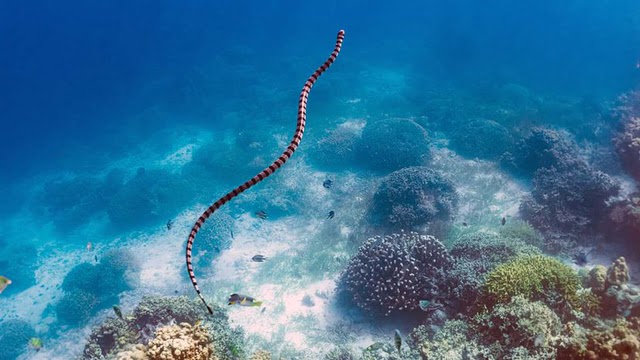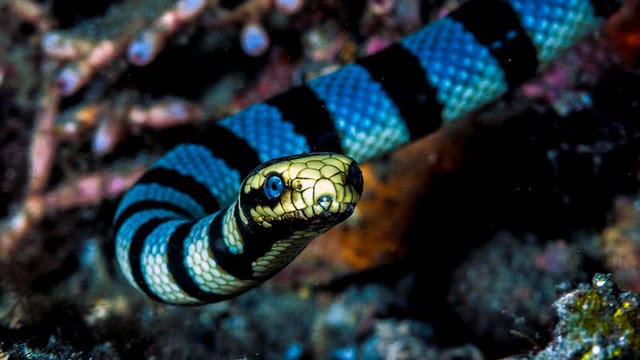Quck answer
Sea snakes are extremely venomous and can be even more dangerous than rattlesnakes. Their venom contains neurotoxins that can cause paralysis and respiratory failure in humans. Unlike land snakes, sea snakes are adapted to life in water and have paddle-like tails to help them swim. They are found in tropical and subtropical oceans around the world and can grow up to 10 feet long. It is important to be cautious around these creatures and seek medical attention immediately if bitten.
Wild Animals

Banded sea kraits, which belong to the cobra family (Elapidae), can be even more venomous than rattlesnakes. These snakes often tie themselves in knots to shed their skin, a process that requires friction that they can’t easily find in the open sea. Shedding their skin frequently also helps to keep hitchhikers like barnacles and oysters off their bodies.
Life in the ocean is challenging for armless, legless air-breathers like sea snakes, but they use amazing tricks to survive. When people talk about “sea snakes,” they are referring to two specific groups of reptiles that are part of the cobra family (Elapidae): true sea snakes (Hydrophiinae) and sea kraits (Laticaudinae).
Nests and Nurseries
True sea snakes, like yellow-bellied sea snakes, have completely adapted to marine life and give birth to live young at sea. In contrast, sea kraits are more competent on land and lay eggs in beachside nests, like sea turtles.

Banded sea kraits spend most of their time underwater hunting, but they return to land to digest, rest, and reproduce.
Super Venom
Despite their docile nature, sea snakes are venomous and can inject their venom through hollow fangs. While they seldom kill humans, their neurotoxic venom can cause paralysis, spasms, and respiratory problems. It’s best to give these fascinating creatures a wide berth to avoid any unnecessary risks.
Fish are the primary food source for most species, and some snakes have developed unique ways of catching them. The yellow-bellied sea snake remains still at the ocean’s surface and waits for fish to take refuge under its coils before striking. Banded sea kraits hunt for eels hiding in coral reefs, and they immobilize morays with venom before swallowing them whole. Some species, like the spine-tailed sea snake, have specialized in eating only fish eggs and have tiny fangs that deliver weak venom. They do not need to paralyze their prey because caviar cannot swim away.
Sea snakes cannot drink seawater, so they must keep hydrated in other ways. Sea kraits lick fresh water droplets off plant leaves when they come ashore and drink from puddles after a storm. Yellow-bellied sea snakes use fresh water lenses that form on the ocean’s surface during rainfall to quench their thirst. Sea kraits and true sea snakes have valves that can seal off their nostrils during dives, and some species can stay underwater for up to three and a half hours. Researchers discovered in 2019 that the blue-banded sea snake can pull oxygen straight out of the water through its intricate blood vessels, a unique superpower.
Sea snakes face threats from pollution and predators such as sharks, crocodiles, and birds of prey. The yellow-lipped sea krait has evolved deceptive markings on its tail to confuse attackers. Sea snakes originated in the western Pacific 6 to 8 million years ago and spread across the Pacific and Indian Oceans. However, they are absent in the Atlantic due to cold water and low rainfall along Africa’s southeastern coast.
The sea snakes need to come up to the surface for breathing as they do not have gills. A photograph of sea snakes is shown above. It is interesting to note that the mimic octopus uses its color-changing ability to deceive predators by resembling a banded sea krait and burying some tentacles in the ocean floor.
FAQ
1. What are sea snakes?
Sea snakes are a type of venomous snake that live in the ocean. They are closely related to cobras and have adapted to life in the water.
2. Where are sea snakes found?
Sea snakes are found in the warm waters of the Indian and Pacific Oceans, from the east coast of Africa to Australia and the western coast of South America.
3. How venomous are sea snakes?
Sea snakes are some of the most venomous creatures in the world. They have incredibly potent venom that can be more toxic than that of a rattlesnake.
4. How do sea snakes hunt?
Sea snakes use their venom to immobilize their prey, which consists mainly of fish and squid. They are able to hold their breath for up to two hours and dive to depths of over 300 feet to find food.
5. Can sea snakes be dangerous to humans?
Yes, sea snakes can be dangerous to humans. However, they are not aggressive and will only attack if they feel threatened. Most bites occur when people accidentally step on them while swimming or diving.
6. How can you avoid getting bitten by a sea snake?
The best way to avoid getting bitten by a sea snake is to stay away from them. If you are swimming or diving in waters known to have sea snakes, wear protective clothing and be aware of your surroundings.
7. What should you do if you get bitten by a sea snake?
If you get bitten by a sea snake, seek medical attention immediately. Sea snake venom can be very potent and can cause paralysis, respiratory failure, and even death.
8. Are sea snakes endangered?
Many species of sea snakes are considered threatened or endangered due to habitat loss, pollution, and overfishing of their prey. It is important to protect these creatures and their ecosystems.
9. What is being done to protect sea snakes?
Conservation efforts are underway to protect sea snakes and their habitats. These include creating marine protected areas, regulating fishing practices, and reducing pollution in the oceans.





Leave a Reply